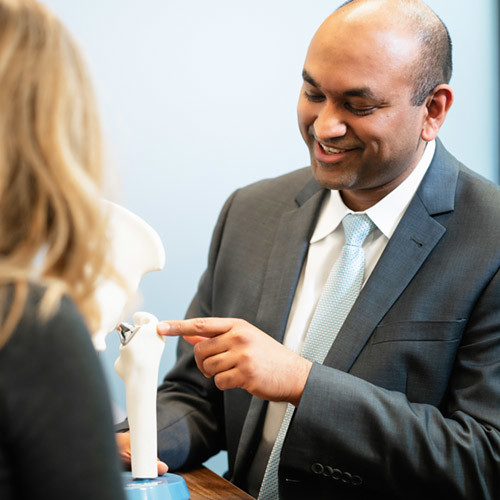
Trochanteric Bursitis
Trochanteric bursitis or hip bursitis is a condition most often found in middle aged or elderly people. It is however; not uncommon in athletes and football or soccer players where extended periods of running are required.
Bursae are found throughout the body, particularly in the shoulder, knee, ankle and hip joints. They are small sacs of fluid, which cushion and lubricate the areas between the bones, muscles and tendons of the joints. When these bursae or sacs become irritated or inflamed, more fluid accumulates in the bursa, and will result in bursitis. Inflammation of the trochanteric bursa is a common cause of hip pain.
Orthopaedics SA in Adelaide is home to many orthopaedic surgeons who are highly experienced in supporting patients with trochanteric bursitis
The hip joint is a ball-and-socket joint where the femur (thigh bone) meets the pelvis. The greater trochanter is a bony prominence on the femur, where several muscles and tenons attach. Covering this area is the trochanteric bursa, a fluid-filled sac that acts as a cushion to reduce friction between the bone and surrounding soft tissues during movement.
Bursae are small sacs filled with synovial fluid, strategically placed in joints throughout the body. Their primary role is to facilitate smooth movement by cushioning and reducing friction between bones, tendons, muscles, and skin. In the hip, the trochanteric bursa ensures that the tendons glide smoothly over the greater trochanter during activities like walking or running.
- Pain is the main symptom of trochanteric bursitis
- The pain will be felt whenever the joint is used and usually extends over the outside or lateral aspect of the hip and often may radiate down the outside of the thigh to the knee
- The pain is typically described as a burning and tingling along the outside of the thigh
- Lying down or rolling onto the affected side increases the level of pain
- People with trochanteric bursitis will experience pain when sitting, standing for long periods of time and when climbing stairs
- Those affected often will have disturbed sleep patterns due to pain experienced at night
- Limping
- Overuse of the joint (repetitive stress)
- A direct fall onto the hip
- Prolonged pressure on the hips from standing for long periods
- Prolonged lying on one side of the body
- Prosthetic hip implants or hip surgery
If trochanteric bursitis is suspected, your doctor will conduct a physical examination of your hip joints. A medical history will also be taken to highlight any significant injury or past surgery to the hip joints.
If required, your doctor will arrange for a x-ray or ultrasound of your hip. These help in the diagnosis by revealing any bony spurs, calcium deposits or other problems, which may be contributing to the bursitis.
Very occasionally an MRI scan (Magnetic Resonance Imaging) may be needed.
Following the examination and the results of any x-rays or scans, your doctor will discuss with you the most likely cause of your bursitis. They may prescribe:
- Rest (short term only) to assist in reducing the inflammation of the bursa. This will also mean identifying the actions or activities which cause you discomfort and making changes where necessary
- Weight loss is encouraged if it is a significant contributing factor to the bursitis
- Conservative treatments such as ultrasound, acupuncture and massage therapy have been found to be of benefit
- Icing the affected area for 15 minutes up to three times per day can also be beneficial. Wrap the ice in a tea towel before using and never apply ice directly to the skin
- Your Doctor will discuss pain relief with you. If tolerated, non-steroidal anti-inflammatory medications may be prescribed
Once the symptoms are controlled a physiotherapist can help with hip and back strengthening/stretching exercises for you. These are important as often bursitis is related to ‘wear and tear’ of the adjacent gluteal tendons – strengthening helps the tendons and thus the bursitis.
If conservative steps do not bring relief, then your doctor may arrange a corticosteroid/local anaesthetic injection into the affected area. This injection can be repeated a few months later.
Surgical Interventions
Surgery is generally considered as last resort in the treatment of trochanteric bursitis, when non-surgical treatments (rest, physical therapy, anti-inflammatory medications) fail to provide relief. Persistent pain, limited mobility, or recurrent flare-ups may indicate the need for surgical intervention and may also involve the worn/torn gluteal tendons.
One common surgical option is a bursectomy, where the inflamed bursa is removed. In some cases, minimally invasive procedures like arthroscopy may be used to remove or repair the damaged bursa and surrounding tissues.
Recovery from surgery typically involves a period of rest followed by physical therapy to restore mobility and strength in the hip. Patients can expect a gradual return to normal activities, with full recovery depending on the extent of the surgery and he individual’s overall health.
If left untreated, trochanteric bursitis can lead to chronic pain, significantly affecting quality of life. The pain can become persistent and may spread to surrounding areas, making it difficult to manage.
Severe or persistent bursitis can result in a decreased range of motion in the hip, leading to difficulty performing daily activities such as walking, climbing stairs, or even sitting for extended periods of time.
Untreated trochanteric bursitis is more likely to recur, especially if the underlying causes are not addressed. This can lead to repeated flare-ups, each potentially more debilitating than the last.
- Age and Gender: The risk of developing trochanteric bursitis increases with age as the bursa becomes less resilient and more prone to irritation. Women are more likely to develop this condition, potentially due to difference in pelvic structure and gait.
- Repetitive Stress: Repetitive activities that involve the hip, such as running, cycling, or prolonged standing, can lead to inflammation of the trochanteric bursa. These repetitive motions can cause friction and irritation, contributing to the development of bursitis.
- Pre-existing Conditions: Certain medical conditions, such as rheumatoid arthritis, gout, or a history of hip surgeries, can predispose individuals to trochanteric bursitis. These conditions can cause chronic inflammation or alter the mechanics of the hip, increasing the risk of bursa irritation.
For those experiencing symptoms of trochanteric bursitis, schedule an appointment at Orthopaedics SA in Adelaide before you develop complications related to untreated trochanteric bursitis. Our specialist orthopaedic surgeons can help you manage trochanteric bursitis and return to a high quality of life.
Explore treatment options
Hip treatments











